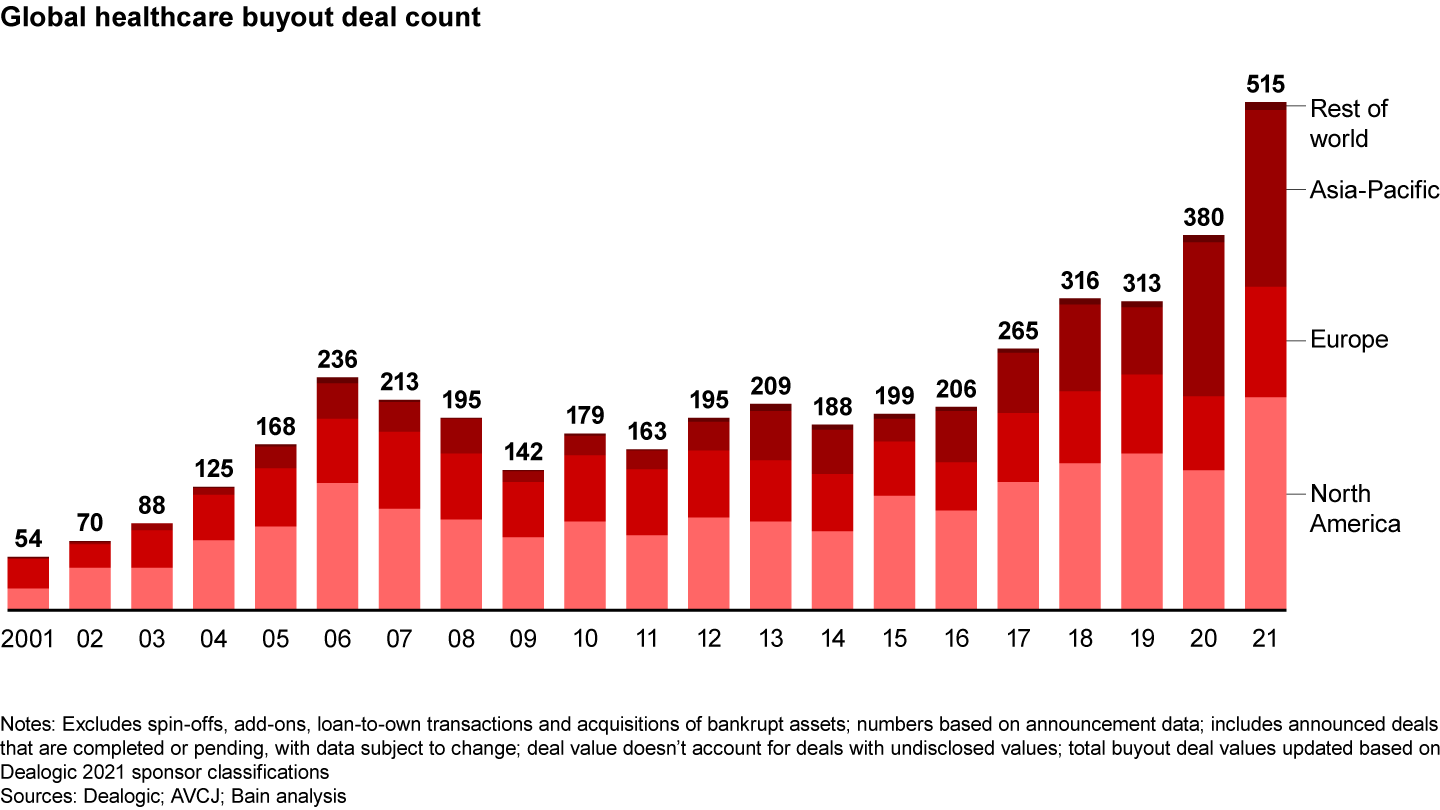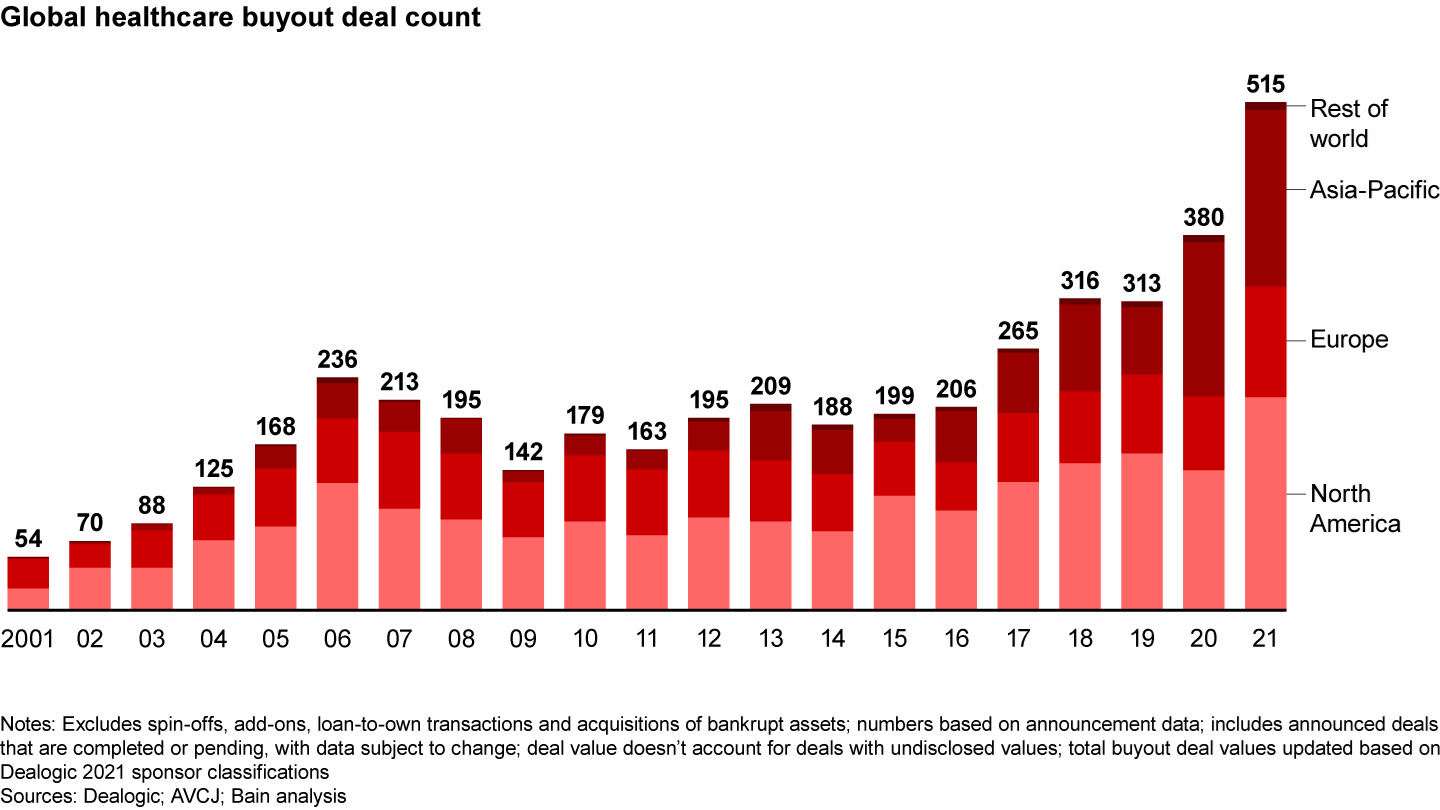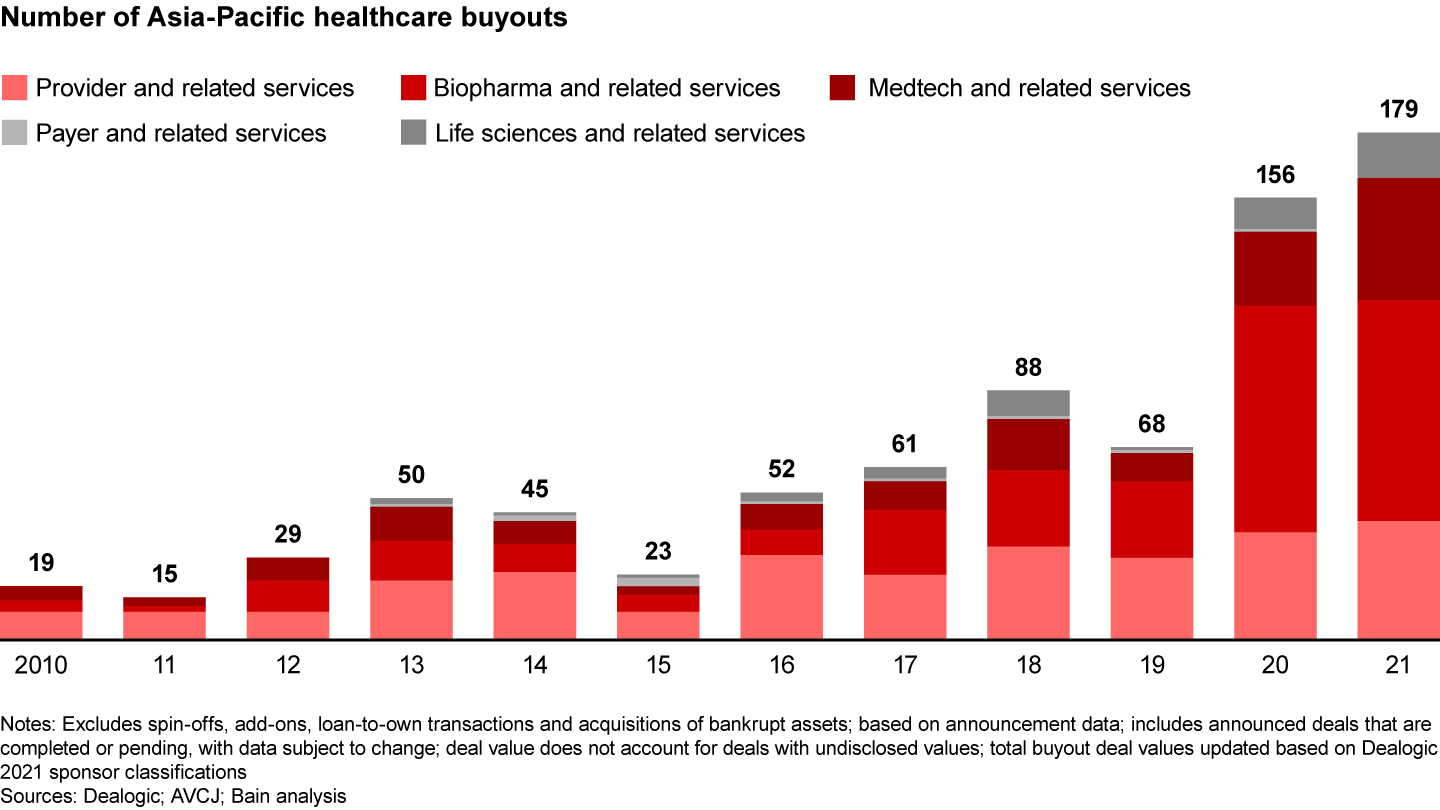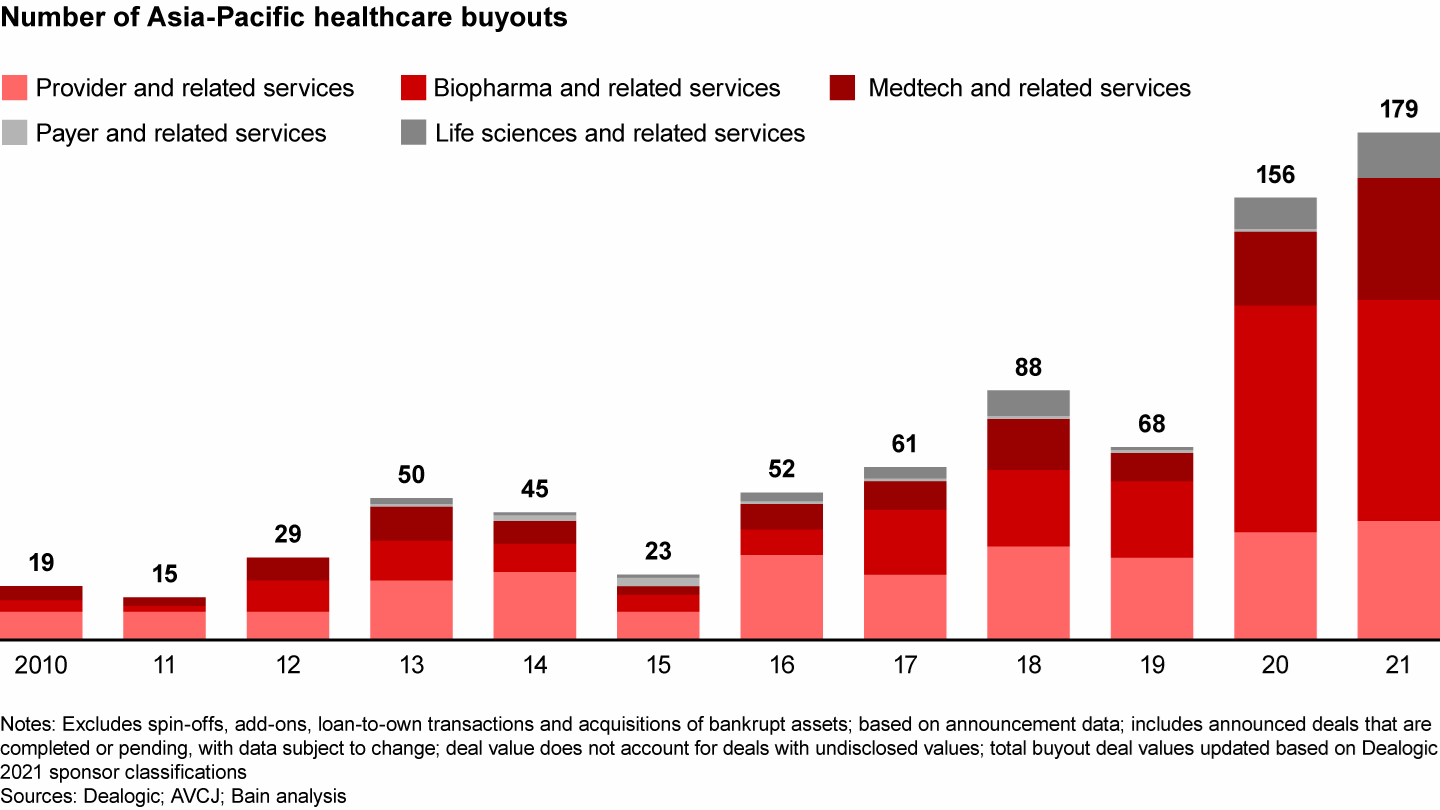レポート

At a Glance
- Deal volume and deal value both rose in 2021 over the steep increases the prior year.
- Favorable consumer behaviors and government regulations have helped build private equity markets, especially in India, China, and Southeast Asia.
- Biopharma continues to make up the largest share of activity, though life sciences tools and medtech posted the largest annual growth, and providers showed sustained activity.
- The region attracted more sources of capital, including growth-equity and infrastructure funds.
This article is part of Bain's 2022 Global Healthcare Private Equity and M&A Report
The number of transactions in 2021 across Asia-Pacific increased to 179 from 156 in 2020, and disclosed value rose slightly to $17.8 billion, from $16.9 billion, as the region continued its multiyear growth trajectory (see Figures 1 and 2). Asia-Pacific markets are seeing increased consumerism and willingness to spend in healthcare, which has fueled activity, especially with investments in building a more robust consumer-centric digital health environment. Additionally, government regulations that support growth, combined with the maturation of many assets, continue to foster an environment for a reasonably strong year for private equity in India, China, and Southeast Asia.




Consumer behavior, government incentives, and new sources of capital
Healthcare is rapidly becoming more consumer-centric, with people more willing to spend out-of-pocket, as well as demand a better customer experience and better whole health outcomes. For example, more patients in Asia-Pacific are using private health systems because they value the experience and level of comfort.
Governments in the region are spurring this behavior through regulations generally supporting private healthcare. As the environment for healthcare assets improves, private equity has flowed in. Local deal volume thus rose in 2021 to 179, up from 156 in 2020, while cross-border deals plunged to 22 from 42 the year earlier.
The region also attracted more sources of capital, including growth-equity and infrastructure funds. The latter have widened their net to capture healthcare assets, and funds such as EQT Infrastructure and Infratril made large plays for Icon Group and Pacific Radiology Group, respectively. Infrastructure funds have more access to capital, and they’re now seeking to take advantage of the attractive returns and inelastic demand in healthcare to diversify their portfolios.
Growth equity, meanwhile, has gained popularity as maturing assets require more capital to scale up, and as the region hungers for more sophisticated IT.
Healthcare providers: advanced delivery models and specialty providers
Advanced healthcare delivery models, including e-pharmacies and direct-to-consumer vendors, continue to attract investment, particularly as Covid-19 has accelerated the adoption of at-home care.
Consider digital-first and tech-enabled care, which were big in India. This activity was primarily driven by growth-equity investments such as API Holdings, an integrated digital healthcare platform, which raised $323 million from Prosus Ventures. API Holdings also is the parent of TPG-backed PharmEasy, an Indian online pharmacy and medical store, which filed for an initial public offering in 2021. Additional activity focused on telemedicine; Temasek-backed Halodoc raised $80 million in a Series C fund-raising round, and Singapore’s Doctor Anywhere raised $66 million in a Series C round led by Asia Partners.
Growth equity also played a role in assets focused on alternative sites of care, specifically in homes. Activity increased throughout Asia-Pacific, including Singapore’s Homage, which focuses on home care for chronic illnesses and received $30 million in Series C funding led by Temasek, and Australia’s Mable, an at-home aged care and disability support services company, which received a $100 million investment from General Atlantic.
Brick and mortar can still thrive, however, and primary care hospitals are focused on reducing costs and streamlining operations. General hospitals remain important throughout the region, through such acquisitions as Malaysian hospital management group Aurelius Healthcare, in which Navis took a majority stake, and New Frontier Health Corporation, including the Chinese hospital group United Family Healthcare, which was taken private by a consortium of investors. Among the deals involving Indian business-to-business services for providers, Baring Private Equity purchased Hinduja Global Solutions, a business process management provider covering the entire life cycle of a payer organization, for $1.2 billion.
Specialty providers also garnered a lot of interest in 2021, including the EQT Infrastructure’s acquisition of Icon Group, Australia’s largest integrated cancer care provider, and Japan’s Tsukui Holdings selling a majority stake to MBK Partners.
Providers have encountered stiff cost pressures throughout the pandemic, and are trying to rein in expenses through outsourcing specialist services such as pathology and radiology. In turn, that spurs consolidation and further investment in these service providers. For example, Infratil bought a stake in Pacific Radiology Group, the largest private diagnostic imaging service provider in New Zealand, on the heels of its diagnostics acquisition of QScan in 2020. Some companies also integrated offline and online operations, such as sponsor-backed PharmEasy buying 66% of Thyrocare, one of the largest pathology lab chains in India.
Biopharma: competition from capital markets cool dealmaking
Biopharma spiked in the region during 2020 to 81 deals and declined only slightly to 78 in 2021, despite greater competition with capital markets. Similarly, disclosed deal value decreased in 2021 to $8.7 billion from $8.9 billion, but overall, Asia-Pacific maintained the record activity of 2020.
Biopharma investors in the region focused mainly on services in the drug development and commercialization process, especially on earlier-stage development that benefits from government support and the influx of new capital. This logic informed GIC’s and Sequoia Capital’s acquisition of a more than 10% stake in Novotech Health Holdings, an Australian-based contract research organization, from TPG Capital. Novotech proved the investment thesis for pharma services, and there were several deals conducted on the heels of TPG’s successful exit, including Riverside’s investment in Avance Clinical, Blackstone acquiring Nucleus Network from Crescent Capital, and Cobepa-backed BioAgilytix acquiring 360biolabs.
India hosted activity in pharma commercialization and manufacturing. One such deal was True North’s purchase of a minority stake in Anthem Biosciences, an integrated drug discovery, development, and manufacturing services provider. Another was Advent International buying a controlling stake in ZCL Chemicals, which manufactures active pharmaceutical ingredients and advanced intermediates.
Life sciences tools: centered on diagnostic equipment and services
Life sciences buyouts in the region surged to 16 in 2021 from 11 in 2020, most involving diagnostic equipment and services. Key investments include Catterton’s $181 million investment in Japan’s PHC Holdings, which manufactures equipment for medical diagnostics, and the $150 million funding led by ABC International for WuXi Diagnostics, a Chinese enabling platform for early diagnostic and clinical insights.
Medtech: China’s local firms prevail
Governmental funding and incentives for home company innovation continued to spur medtech activity in Asia-Pacific, particularly China. Deal volume exploded in 2020 to 26 deals from 10 the prior year, and rose substantially again in 2021 to 43 deals, 34 involving Chinese assets. Many of these local manufacturers compete in high-tech fields such as heart valves and cardiac implants. For instance, NewMed Medical, a Shanghai-based artificial heart valve system supplier, raised over $100 million in its Series C round led by Temasek, and medical devices developer Hangzhou Valgen Medtech has raised hundreds of millions of dollars in a Series B round led by DCP and Sequoia Capital China.
Healthcare IT: the digital transformation continues
PE firms logged only 7 healthcare IT deals in 2021, slightly above the 5 in the previous year. Many of these investments and acquisitions fueled an ongoing digital transformation, particularly in India and Southeast Asia. Growth equity participated, mostly in the provider sector, but activity also included biopharma deals such as the $255 million Series C investment in the Hong Kong company Insilico Medicine, led by Warburg Pincus. Corporate acquirers landed 159 deals, including 3 exit opportunities for sponsors, such as Affinity Equity Partners’ $257 million exit of MedicalDirector, an Australian clinical and practice management software, by selling to Telstra Health.
Outlook: biopharma and medtech could draw more capital
Investors in Asia-Pacific will likely keep their eyes trained on the biopharma and medtech sectors. A few themes with legs include the continued adoption of digital-first and other advanced provider models, drug development and commercialization services, and more mature assets coming to market with government assistance.